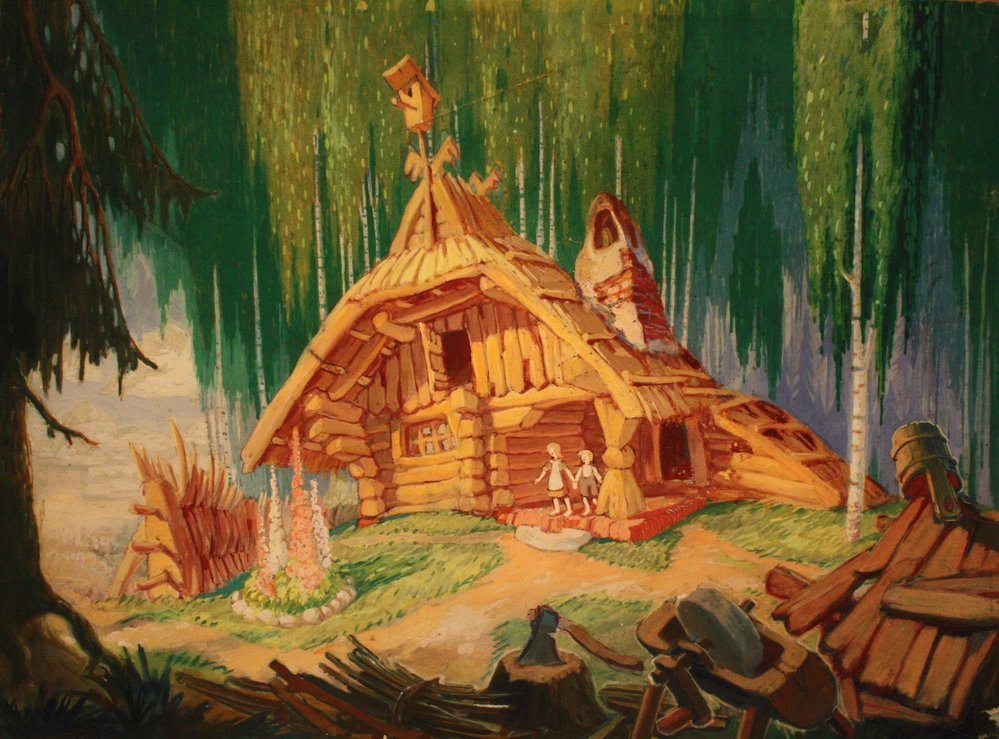Stop 24

Hansel and Gretel’s Homestead. Set design for the Michael Myerberg film production of Hansel and Gretel, based on Engelbert Humperdinck’s opera. | Ansīša un Grietiņas mājvieta. Dekorācija Maikla Mierberga (Michael Myerberg) filmai Ansītis un Grietiņa, pēc Engelberta Humperdinka operas.
Tempera, 14.75 in x 19.75 in (37.50 cm x 50.17 cm), 1952. Private collection of Ieva Ruks-Politzer.
In 1952 my father began working for Michael Myerberg Productions' studios located in Manhattan’s Greenwich Village. As the set designer for the studio's stop motion-animated film Hansel and Gretel, my father was hired to conceptualize the Engelbert Humperdinck opera in a fresh new visual idiom that did not use familiar Brothers Grimm, Black Forest settings. My father proposed that the film’s sets be interpreted in keeping with the distinct architectural styles and natural environments of Latvia that he knew so well. Some concept sketches of what was possible were shown to the producer, Michael Myerberg, and work on the production began soon thereafter. The film premiered on October 10, 1954. In his screen review of Hansel and Gretel, the New York Times film critic Bosley Crowther wrote:
"Humperdinck's Hansel and Gretel is a children's opera that is frequently performed with musical care and distinction on the operatic stage, so Michael Myerberg was inviting stern comparisons when he chose to do it in a film. Furthermore, he was challenging tradition and the pitfalls of uncertain artistry when he chose to do it with animated puppets of a sort never used before—little plastic-skinned, trimly costumed figures, operated by electricity. He calls these little figures "kinemins," and they constitute his "cast." But his daring has admirably paid off in the film, which opened yesterday afternoon at the Broadway Theatre for what should deservedly be an extended run. For the work is a charming entertainment in both the musical and the novelty line."
1) Model of Hansel and Gretel's homestead; 2) Scene from the movie of their homestead
In His Own Words:
Hansel and Gretel (Stops 24 – 25)
“I began to design scenery for film. Working at a very quick pace, I prepared concept sketches, technical drawings and was given a variety of practical production assignments. Problems needed to be worked out with the aid of an interpreter—quickly and efficiently. While gradually learning to speak English, I ended up working at the Myerberg Studios for almost three years.
During that period I designed sets for the film version of Humperdinck’s opera Hansel and Gretel. The producer did not want to have romantic, Germanic-style period settings for the film, through appropriate for this work. I brought to the project unfamiliar Latvian stylistic details, especially for the buildings. The producer found these designs quite satisfactory. In addition to Hansel and Gretel, I developed the scenic design for the film Aladdin and His Wonderful Lamp and for the Broadway production of the play Thirteen Daughters which was set in Hawaii. Unfortunately, Michael Myerberg’s untimely death interrupted and stopped this work.”
Viņa
paša vārdos:
Ansītis un Grietiņa:
Dekorācijas amerikāņu filmai (24. un 25. pietura)
„Sākās mans pārbaudes laiks. Darbs saistījās ar filmas dekorācijām. Ātrā tempā bija jātaisa ideju skices, techniski zīmējumi un praktiski izdevuma darbi. Problēmas bija jānoskaidro ar tulka palīdzību – īsi un aši. Valodu pamazām apgūdams, Myerberg studijā nostrādāju turpat trīs gadus. Šai laikā devu dekoratīvo ietērpu Humperdinka operas filmai Ansītis un Grietiņa. Producentam nevisai patika vāciskais romantiskā laikmeta stils, kas būtiski šim darbam piederējās. Ievedu darbā gluži nepazīstamas latviskā stila detaļas, sevišķi celtnēs. Tās producentam likās pavisam pieņemamas. Pēc Ansīša un Grietiņas, gatavoju metus filmai Aladīna Burvju lampa un havajiešu lugai Thirteen Daughters. Bet Myerberg pēkšņā nāve pārtrauca un izbeidza šo darbību.”

